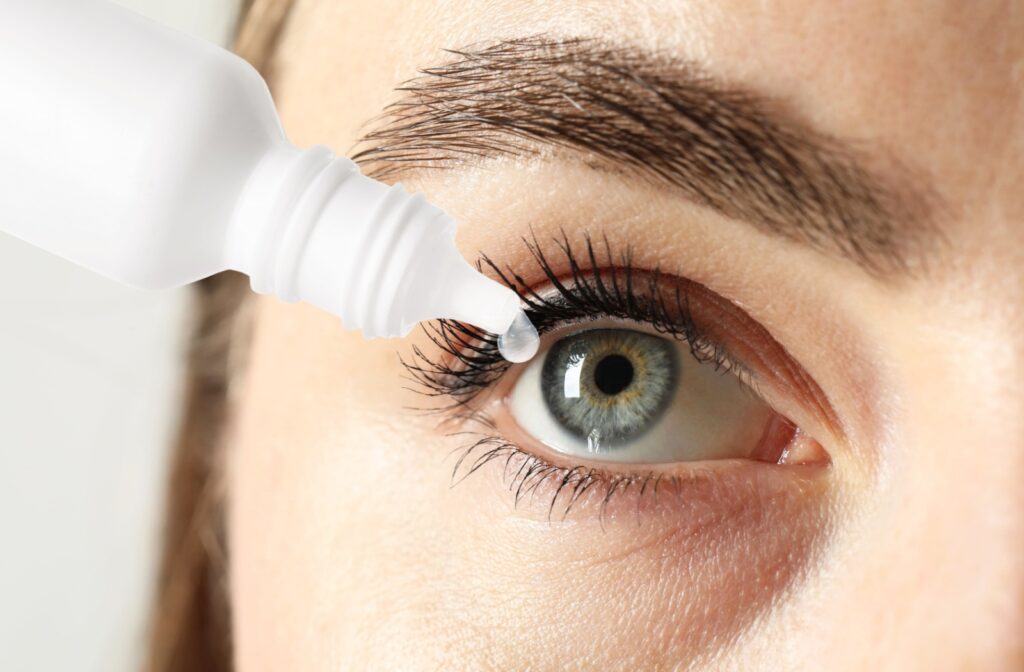If you’ve been dealing with dry, itchy eyes or unexpected bouts of blurry vision, you might be encountering Meibomian Gland Dysfunction (MGD). This common but often misunderstood condition can significantly impact your daily life and overall eye health. Meibomian Gland Dysfunction is often a chronic condition that requires long-term management, but some people may experience quick symptom relief in minor cases.
There is a mixture of at-home and professional or medical dry eye treatments that can help bring you effective relief. Your eye doctor will often recommend a mixture of both. For example, they may recommend that you keep up with consistent warm compresses at home and prescribe an anti-inflammatory eye drop to help control your symptoms.
What Is Meibomian Gland Dysfunction?
MGD is an eye condition in which the tiny oil glands in your eyelids become blocked or don’t function properly. These glands play a vital role in producing the oily layer of your tear film, which helps keep your eyes moist and prevents tears from evaporating too quickly. When these glands aren’t working as they should, it can result in symptoms like dryness, irritation, and inflammation.
Experts estimate that over a third of the world’s population has MGD, which is one of the leading causes of dry eye syndrome. While it’s not life-threatening, it can significantly impact your comfort and quality of life.
Understanding the Causes of MGD
It’s essential to examine MGD’s causes because of its chronic nature. If you don’t deal with the cause, the condition will likely persist. MGD can stem from many factors, including:
Lifestyle Habits
Prolonged screen time, which reduces blinking and hampers the natural oil flow from your glands, can increase the risk of MGD. Poor eyelid hygiene can also increase this risk, especially if makeup residue builds up around the glands.
Environmental Influences
Exposure to dry or windy climates can contribute to gland issues. In addition, air-conditioning or heating systems often exacerbate dryness, which causes your eyes to work harder to stay hydrated.
Medications & Contact Lens Usage
Some medications, such as antihistamines or acne treatments, can reduce tear production. Long-term, improper contact lens use can also disrupt the natural tear film and gland health.
Symptoms of MGD to Watch For
MGD doesn’t present with a single clear-cut symptom. Its effects can vary widely, which highlights the importance of visiting your eye doctor for an accurate diagnosis. Common signs of MGD include:
- Dry, itchy, or burning eyes: Your eyes might feel uncomfortable, especially after extended computer use or exposure to air conditioning
- Blurry vision: An uneven tear film may cause intermittent blurred vision
- Excess tears: MGD can lead to excess tears as your eyes attempt to counter the dryness
- Redness: The irritation from your dry eyes can cause them to appear red
- Sensitivity to light: Light sensitivity is a common symptom when your tear film is affected
If you experience these symptoms, it’s a good idea to consult a professional. Early intervention can prevent MGD from worsening.

Treatment Options for MGD
There’s no one-size-fits-all solution for MGD, but treatment typically includes a mix of professional care and at-home remedies. The right treatment ultimately depends on the root cause of your MGD. Your eye doctor can offer expert advice on suitable treatments.
At-Home Remedies
A few things you can try at home include:
- Warm compresses: Applying a warm compress can loosen blockages in your meibomian glands and stimulate better oil flow
- Eyelid hygiene: Use gentle cleansers or wipes to remove debris and bacteria from your eyelid margins
- Omega-3 supplements: Some studies suggest omega-3 supplements can improve gland function
Medical Interventions
Your eye doctor may recommend these medical interventions:
- Artificial tears: These restore hydration to your eyes.
- Prescription drops: Prescription drops target specific symptoms and causes when over-the-counter eye drops aren’t sufficient.
- Punctal plugs: This refers to tiny devices implanted into your tear ducts that stop tears from draining too quickly.
- IRPL therapy: Uses light pulses to reduce inflammation and improve meibomian gland function. This non-invasive treatment can enhance tear film quality and provide lasting relief from dry eye symptoms.
- Meibomian gland expression: Applies gentle pressure to clear blockages and improve oil secretion from the meibomian glands. Regular expression can help maintain the health of your tear film and alleviate discomfort from dry eyes.
How Long Does MGD Last?
The duration of MGD can vary depending on several factors:
- Condition’s severity: Milder cases may resolve relatively quickly, whereas chronic MGD might take months or more to effectively manage
- Early diagnosis and treatment: Catching the condition early can speed up recovery
- Treatment consistency: Regularly following prescribed treatments and maintaining proper eyelid hygiene is critical.
While some individuals may achieve symptom relief quickly, MGD is often considered a chronic condition, meaning flare-ups can occur throughout life. Long-term management plays a vital role in keeping symptoms under control.
Early Action is the Key to Healthier Eyes
MGD can be uncomfortable, but you can manage it effectively with the proper treatment and preventive measures. Whether using warm compresses, visiting your eye doctor, or making mindful changes to your lifestyle, every step counts toward improving your vision and eye comfort.Contact our experienced team at Invision Eyecare to book an exam today. Our experienced eye doctors can provide expert knowledge and treatment advice for your dry eye symptoms, and determine whether MGD is the root cause.



